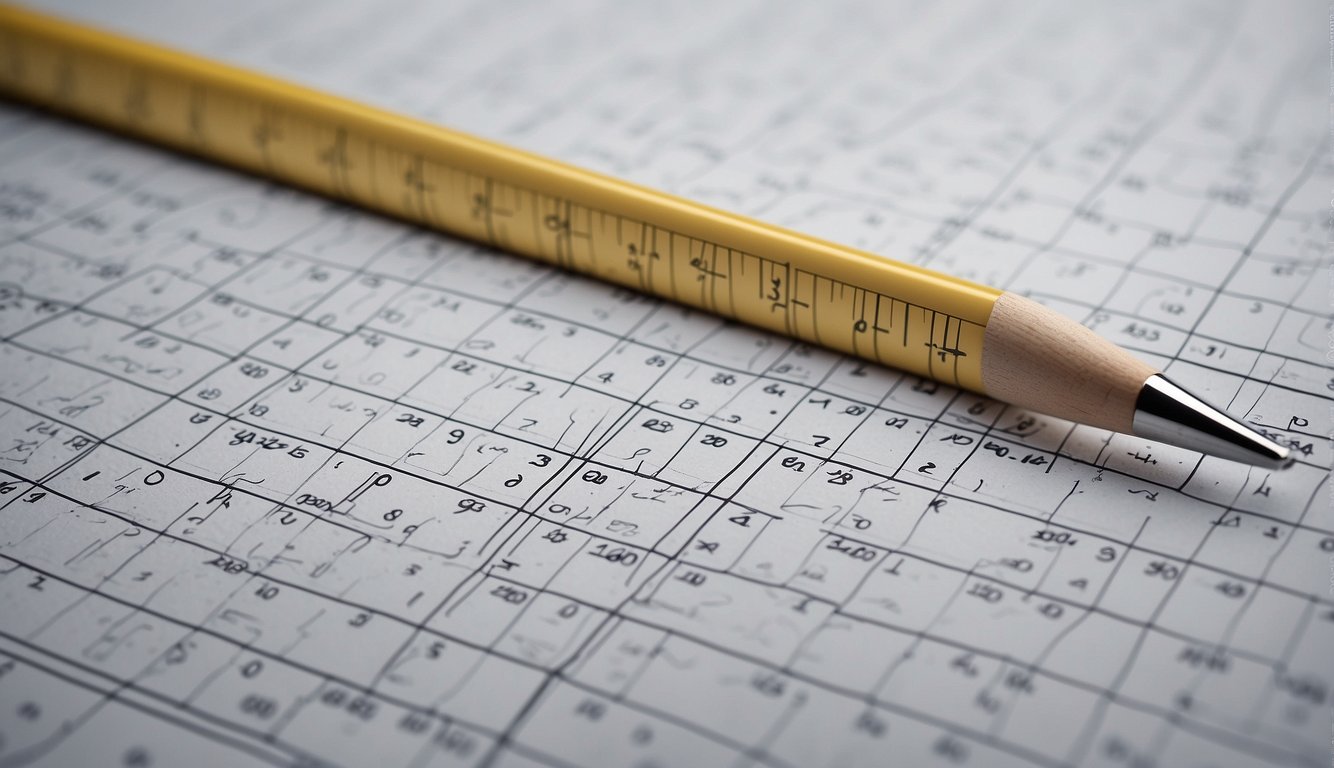Plotting graphs is an essential part of the process when conducting physics experiments.
Graphs help to visualize the data collected, making it easier to analyze and draw conclusions. However, it is crucial to understand how to plot graphs correctly and choose the appropriate scale to ensure accurate and meaningful results.
To begin, you must first determine the type of graph that is most suitable for your data.
Common types of graphs used in physics practicals include line graphs, scatter plots, and bar graphs.
Line graphs are ideal for showing the relationship between two variables, while scatter plots are useful for displaying the correlation between two sets of data.
Bar graphs, on the other hand, are best for comparing different quantities.
Once you have determined the graph type to use, choosing an appropriate scale is essential.
The scale of a graph refers to the range of values represented on the x and y axes. Choosing the correct scale is crucial as it affects the accuracy of the data presented. If the scale is too small, the graph may appear cluttered, making it difficult to read.
On the other hand, if the scale is too large, small changes in the data may be overlooked. Therefore, choosing a scale that allows for a clear and accurate representation of the data is essential.
Table of contents
Graphing in Physics

When plotting graphs in physics practical, it is essential to understand the fundamentals of graphing. This will help you to choose the appropriate scales and label the axes correctly, making it easier to interpret your results.
Understanding Axes and Scales
The axes of a graph represent the variables being measured. The horizontal axis is typically the independent variable, while the vertical axis is the dependent variable. The origin of the graph is where the two axes intersect.
The scale of a graph refers to the range of values represented on each axis. Choosing an appropriate scale that will allow you to represent the data accurately is essential. If the scale is too small, the graph may be difficult to read, while a scale that is too large may not show the necessary detail.
Selecting Appropriate Scales
Choosing the appropriate scales for your graph is crucial. The scale should be chosen based on the range of values being measured and the size of the graph paper. If the range of values is small, a smaller scale can be used, while a larger range of values may require a larger scale.
It is also important to consider the size of the graph paper. If the graph paper is small, a larger scale may be necessary to show the necessary detail. However, a smaller scale may be appropriate if the graph paper is large.
Labelling Axes Correctly
Labeling the axes correctly is essential for interpreting the results of a graph. The independent variable should be labelled on the horizontal axis, while the dependent variable should be labelled on the vertical axis. It is also important to include the units of measurement for each axis.
The labels should be clear and concise, making the data being represented easy to understand. It is also important to include a title for the graph, describing what the graph represents.
By understanding the fundamentals of graphing in physics, you can choose appropriate scales and label the axes correctly, making it easier to interpret your results.
Plotting Data Points

When conducting a physics practical, plotting data points is essential for analyzing and interpreting your results.
Here are some key steps to follow when plotting your data points:
Setting Up the Graph Table
Before plotting your data points, you need to set up a graph table. This table should include columns for your independent and dependent variables and any other relevant data.
Make sure to label each column clearly and include units of measurement where necessary.
Determining Data Point Placement
Once you set up your graph table, you can start plotting your data points. When doing so, use a consistent and appropriate scale for each axis. You should also consider the range of values for each variable and adjust the scale accordingly.
When plotting your data points, use a symbol or marker that is easily distinguishable and clearly visible. You can also use different colors or shapes to represent different sets of data. Make sure to label each point with its corresponding value.
Dealing with Outliers and Anomalous Values
Outliers and anomalous values can sometimes occur when collecting data. These values can significantly affect your results and should be dealt with carefully.
One way to handle outliers is to exclude them from your analysis altogether. However, before doing so, carefully consider the cause of the outlier and whether it results from an error or a genuine data point.
Another approach is to use a statistical method to identify and remove outliers. This can be done using methods such as the Z-score or the interquartile range.
In summary, when plotting data points in a physics practical, it is important to set up a clear and organized graph table, use a consistent and appropriate scale, and carefully consider any outliers or anomalous values. By following these steps, you can ensure accurate and reliable results.
Drawing Graphs

When plotting graphs in physics practical, you need to follow a few key steps to ensure accuracy and clarity.
Following these steps, you can create a graph that effectively communicates your data and supports your conclusions.
Choosing the Right Graph Paper
The first step in drawing a graph is choosing the right graph paper type. Graph paper comes in various sizes and grid patterns, so selecting one that is appropriate for your data is important.
If your data has a wide range of large values, you may need to use a larger graph paper with wider grids.
On the other hand, if your data has small values or a narrow range, you may need to use a smaller graph paper with narrower grids.
Using a Ruler and Pencil
Once you have selected the appropriate graph paper, the next step is to use a ruler and pencil to plot your data points.
Use a sharp pencil to make small dots on the graph paper at the appropriate coordinates. Then, use a ruler to draw a straight line connecting the dots.
Plotting the Line of Best Fit
After plotting your data points, the next step is to draw the line of best fit. This is a straight line that best represents the trend in your data.
To draw the line of best fit, use a ruler to draw a straight line that passes as close as possible to all of your data points.
Interpreting Slope and Intercepts
Once you have drawn your graph, it’s important to interpret the slope and intercepts. The slope of the line represents the rate of change between the two variables being plotted.
The intercepts represent the values of the dependent variable when the independent variable is zero. By interpreting these values, you can better understand the relationship between the two variables.
Following these steps and using the appropriate tools can create a clear and accurate graph that effectively communicates your data.
Advanced Graphing Techniques

Plotting Non-Linear Relationships
In some physics experiments, the relationship between two variables may not be linear. In such cases, it is important to accurately plot the data to represent the relationship between the variables.
One way to do this is by using a curve of best fit. A curve of best fit is a line representing the general trend of the data points on a graph.
To plot a curve of best fit, you can use a software program such as Microsoft Excel or GraphPad Prism. These programs have built-in algorithms that can calculate the best-fit curve for your data. Once you have plotted your data points and added the curve of best fit, you can analyze the graph to draw conclusions about the relationship between the variables.
Calculating Gradient and Area
When analyzing a graph in physics, it is often important to calculate the gradient and area of the plotted data. The gradient represents the steepness of the line on the graph, while the area represents the total amount of space under the curve.
To calculate the gradient of a line, you can use the formula:
gradient = (y2 - y1) / (x2 - x1)
where (x1, y1) and (x2, y2) are two points on the line.
You can use numerical integration techniques to calculate the area under a curve. These techniques involve breaking the area into small sections and calculating the area of each section. The total area is then the sum of the sections’ areas.
Practical Application in Physics Lab

Plotting graphs and choosing the appropriate scale is crucial for accurate data analysis when conducting experiments in a physics lab.
Here are some guidelines for applying these techniques in your lab experiments.
Setting Up the Experiment
Before starting the experiment, planning and determining which variables need to be measured is important. This will help you decide which type of graph to use.
For example, a scatter plot may be appropriate if you are measuring the relationship between two variables. On the other hand, if you are measuring the change in a single variable over time, a line graph may be more suitable.
Once you have determined the type of graph you need, you can choose the appropriate scale for each axis. Selecting a scale that allows you to see the data points without overcrowding clearly the graph is important.
For example, if you are measuring a range of values from 0 to 10, using a scale from 0 to 12 may be appropriate to allow for some extra space on the graph.
Recording Observations and Measurements
It is important to be as accurate as possible when recording observations and measurements. This includes recording the units of measurement and any uncertainties associated with the measurement.
It is also important to record any relevant data that may affect the experiment’s outcome, such as the temperature or humidity in the lab.
Creating a Comprehensive Report
After collecting and analyzing the data, creating a comprehensive report that includes all relevant information is important.
This consists of a clear and concise description of the experiment, the data collected, any calculations performed, and the conclusions drawn from the data.
In the report, including the graphs created during the experiment is important. The graphs should be labeled clearly and include the units of measurement for each axis. Any trends or patterns observed in the data should be discussed in the report, along with any possible sources of error.
By following these guidelines, you can ensure that your physics lab experiments are accurate and reliable and that your data is presented clearly and concisely.
Common Issues and Solutions

Addressing Precision and Accuracy
When plotting graphs and choosing scales in a physics practical, it is important to ensure precision and accuracy.
Precision refers to the ability to obtain consistent results, while accuracy refers to the closeness of a measurement to its true value. Common issues that can arise include imprecise measurements, incorrect units, and incorrect data analysis.
It is important to take multiple measurements and calculate the average to address precision issues. This will help to reduce random errors and increase precision. Using appropriate measuring instruments and ensuring they are calibrated can also improve precision.
To address accuracy issues, it is important to ensure that the correct units are used and that any systematic errors are identified and corrected. Systematic errors can arise from equipment or experimental design, leading to inaccurate results.
Correcting for Systematic Errors
To correct systematic errors, it is important to identify the source of the error and take appropriate measures to eliminate or reduce it. This can involve using different equipment or adjusting experimental procedures.
One common source of systematic error is zero error, which occurs when the measuring instrument does not read zero when nothing is being measured. The instrument should be reset to zero before taking any measurements to correct this.
Another source of systematic error is parallax error, which occurs when the observer’s position affects the reading on the measuring instrument. It is important to position the observer directly in front of the measuring instrument to correct this.
By addressing precision and accuracy issues and correcting for systematic errors, you can ensure that your physics practical is reliable and produces accurate results.
